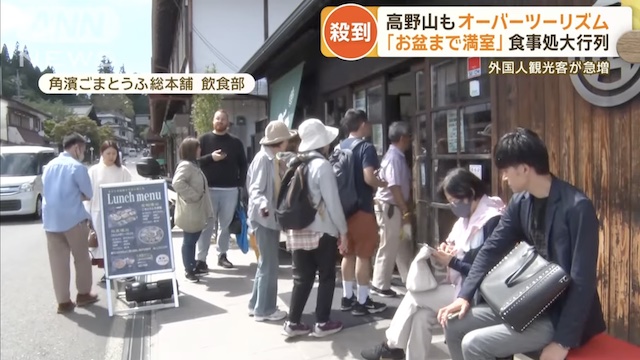Wakayama, May 09 (News On Japan) - Mount Koya, a UNESCO World Heritage site enveloped by mountains standing at 1,000 meters, welcomes visitors into its sacred expanse established 1,200 years ago by the monk Kukai. However, this revered site is facing a severe overtourism crisis, with tourists exceeding the local population of 2,600 by 500 times, leading to illegal parking and dining difficulties.

Residents and officials are grappling with the influx. A temple priest mentioned, "We're booked up to six months in advance." The proprietor of a restaurant specializing in vegan dishes informed us of the long waits, "Even getting a table takes 40 to 50 minutes."
Mayor of Koyasan revealed the gravity of the situation, "We host over 1.4 million visitors annually. Supporting this number with our current population will become increasingly difficult."
The peak seasons transform the area, making it hard for visitors to find a meal. The town hosts 117 temples and 51 lodgings spread across a 6 km east-west and 2 km north-south basin, attracting tourists, notably from Europe and the U.S., due to the weak yen. A French tourist expressed fascination, "I came to learn about Japan's historical religions, cultures, and traditions. Everything is so different from France, which is intriguing."
The town struggles to manage the day-to-day impact of these visitors. "When it's peak season at Mount Koya, it's tough to get a meal," explained the head of the Tourism Promotion Department, Toshiki Chahara. Despite efforts to cater to foreign tourists with amenities like beds and English signs in lodgings, the sheer volume is overwhelming.
Illegal parking is a significant issue. Chahara noted, "With Mount Koya being a basin town on a mountain, it’s challenging to create enough parking spaces." The town has arranged for 650 parking spots, but this is insufficient during peak times when up to 7,000 cars may enter daily.
The local residents feel the strain, as Ryoko Takane, a seller of Buddhist altar offerings, voiced concerns about emergency services, "We only have two ambulances. If tourists have accidents, there might not be enough emergency services for the locals."
Overtourism is not just about visitor numbers but also encompasses waste management challenges. Chahara explained the meticulous approach to keeping the town clean, "If we place garbage bins, they end up overflowing and look unsightly. We are carefully managing to keep our streets clean without them."
Proposals are being considered to mitigate the impact, including a park-and-ride system. Mayor Yoshiya Hirano suggested, "An extreme measure could be to stop cars from entering Mount Koya altogether, parking them in nearby areas and using public transport to ferry people."
As discussions continue, plans are underway to potentially implement a visitor tax in four years. This would help manage the resources needed to maintain the town and its services amidst growing tourism pressures.
Amidst these challenges, the spirit of Buddhism's teachings on mutual assistance and coexistence remains a guiding principle for Mount Koya, as noted by Priest Goto, "The spirit of mutual assistance is something none of us should forget. It's essential that we all work together and coexist to build a community that lasts into the future."
Source: ANN














